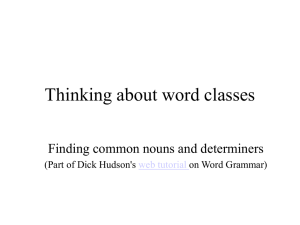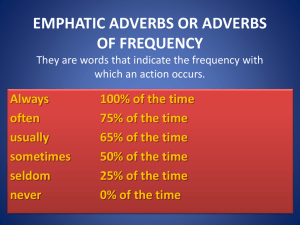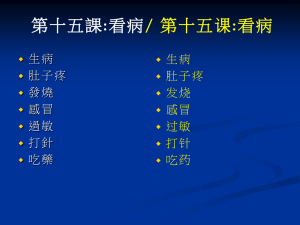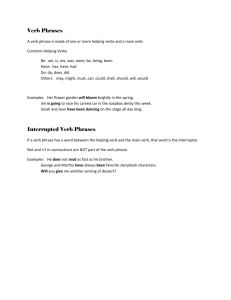07b 2nd position
advertisement
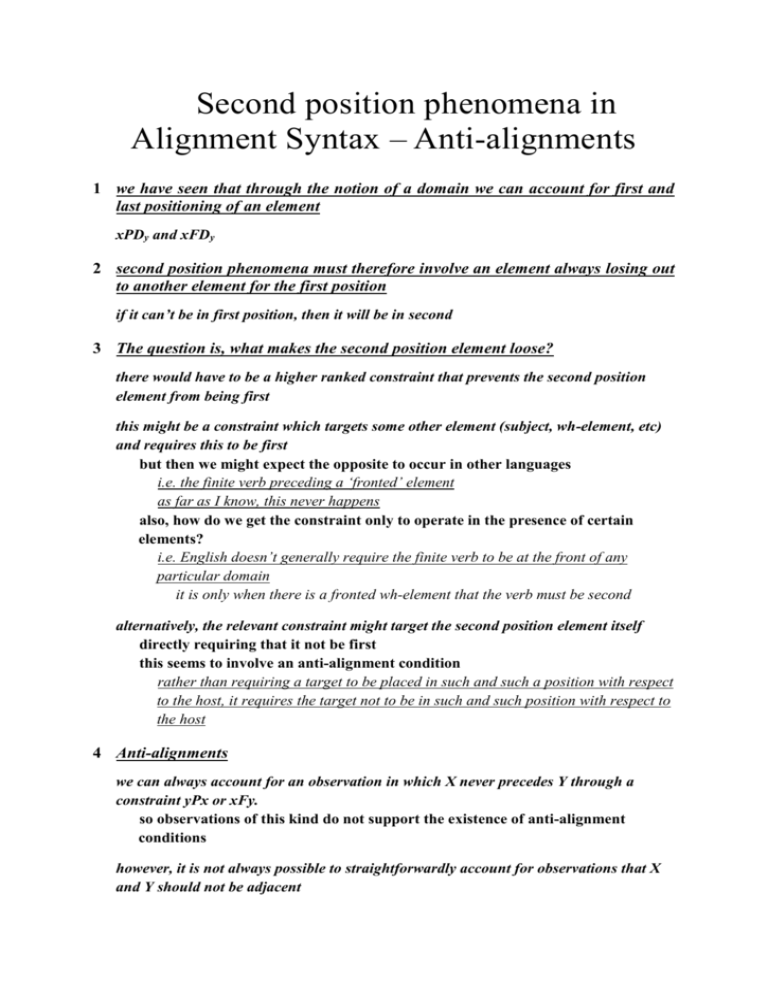
Second position phenomena in Alignment Syntax – Anti-alignments 1 we have seen that through the notion of a domain we can account for first and last positioning of an element xPDy and xFDy 2 second position phenomena must therefore involve an element always losing out to another element for the first position if it can’t be in first position, then it will be in second 3 The question is, what makes the second position element loose? there would have to be a higher ranked constraint that prevents the second position element from being first this might be a constraint which targets some other element (subject, wh-element, etc) and requires this to be first but then we might expect the opposite to occur in other languages i.e. the finite verb preceding a ‘fronted’ element as far as I know, this never happens also, how do we get the constraint only to operate in the presence of certain elements? i.e. English doesn’t generally require the finite verb to be at the front of any particular domain it is only when there is a fronted wh-element that the verb must be second alternatively, the relevant constraint might target the second position element itself directly requiring that it not be first this seems to involve an anti-alignment condition rather than requiring a target to be placed in such and such a position with respect to the host, it requires the target not to be in such and such position with respect to the host 4 Anti-alignments we can always account for an observation in which X never precedes Y through a constraint yPx or xFy. so observations of this kind do not support the existence of anti-alignment conditions however, it is not always possible to straightforwardly account for observations that X and Y should not be adjacent e.g. two determiners should never be adjacent a hen’s egg an egg of a hen which indefinite is marked by the determiner and which is not? a hen’s eggs the eggs of a hen here the determiner belongs to the possessor the hen’s egg the egg of a hen an egg of the hen as both these interpretations are ok, it seems that the determiner can belong to either noun but if this is so why can’t we have a the hen’s egg a a hen’s egg a the hen’s egg the the hen’s egg in Hungarian, the effect is even more obvious az ö háza (determiner definitely with the possessed noun - * az ö) az ember háza (determiner definitely with possessor noung - * ember) * az az ember haza az embérnek a háza Because the effect is that one determiner must delete, it would be difficult to account for this in terms of a higher ranking constraint concerning some other element e.g. the complementiser cannot be adjacent to the finite verb (that-trace) * who do you think that saw Bill who do you think that Bill saw Again, as the phenomena involves the displacement of one element to a position it would not otherwise occupy, it is difficult to account for why the complementiser cannot appear here in terms of something else wanting to be next to the finite verb In such cases an anti-alignment constraint might make analyses easier 5 Anti-alignments with respect to domains we have seen that x*Py is equivalent to yPx or xFy but this is not the same when the host is a domain x*PDy is not the same as xFDy the first says that x cannot be first, the second says that x must be last these are not the same condition therefore domain based anti-alignments cannot be replicated with positive alignment conditions 6 second and second to last phenomena we can achieve the desired results with the following ranking x*PD > xPD i.e X can’ x*FD > xFD 7 English the English verb appears in the second position of the argument domain recall that the argument domain is ordered by a set of constraints arg1PDarg > arg2PDarg ... we then introduce the constraints v*PDarg > vPDarg note that this will not affect the working of the constraints relevant for ordering the arguments as the verb is not a member of the argument domain – this does not prevent it from being positioned with respect to this domain, however. 3v21 3v12 2v13 2v31 1v32 1 v 2 3 v123 12v3 123v a1PD a2PD a3PD v*PD vPD **! * * *! ** * *! ** * **! * * **! * * * ** * * ** *! * ** **! * ** ***! For this reason, the verb will still be in second position in the domain even if there are adverbial elements between it and the first argument so the standard assumption that English SVO word order is not second position phenomena can be discarded the verb appears in the second to last position of the Inflection domain the inflection domain is organised tense > perf > prog > pass this can be achieved through the appropriate ranking of inflection domain constraints we add the following: v*FD > vFD PGvT PTvG GPvT GTvP TGvP T P v G vTPG TvPG TPGv tPD pPD gPD v*FD vFD **! * * *! ** * **! * * *! ** * **! * * * ** * * ** ***! * ** **! * ** *! * Finally, we need to get the whole thing together this works in the following way 1TPvG23 the positioning of the verb with respect to both domains does most of the job but the inflection domain is closer to the verb and so gets situated in the second position of the argument domain This can be achieved with a set of adjacency constraints tAv, pAv, gAv these will be ranked below the domain based constraints so that they will not interfere with the basic order, but they will be ranked above the argument adjacency constraints



